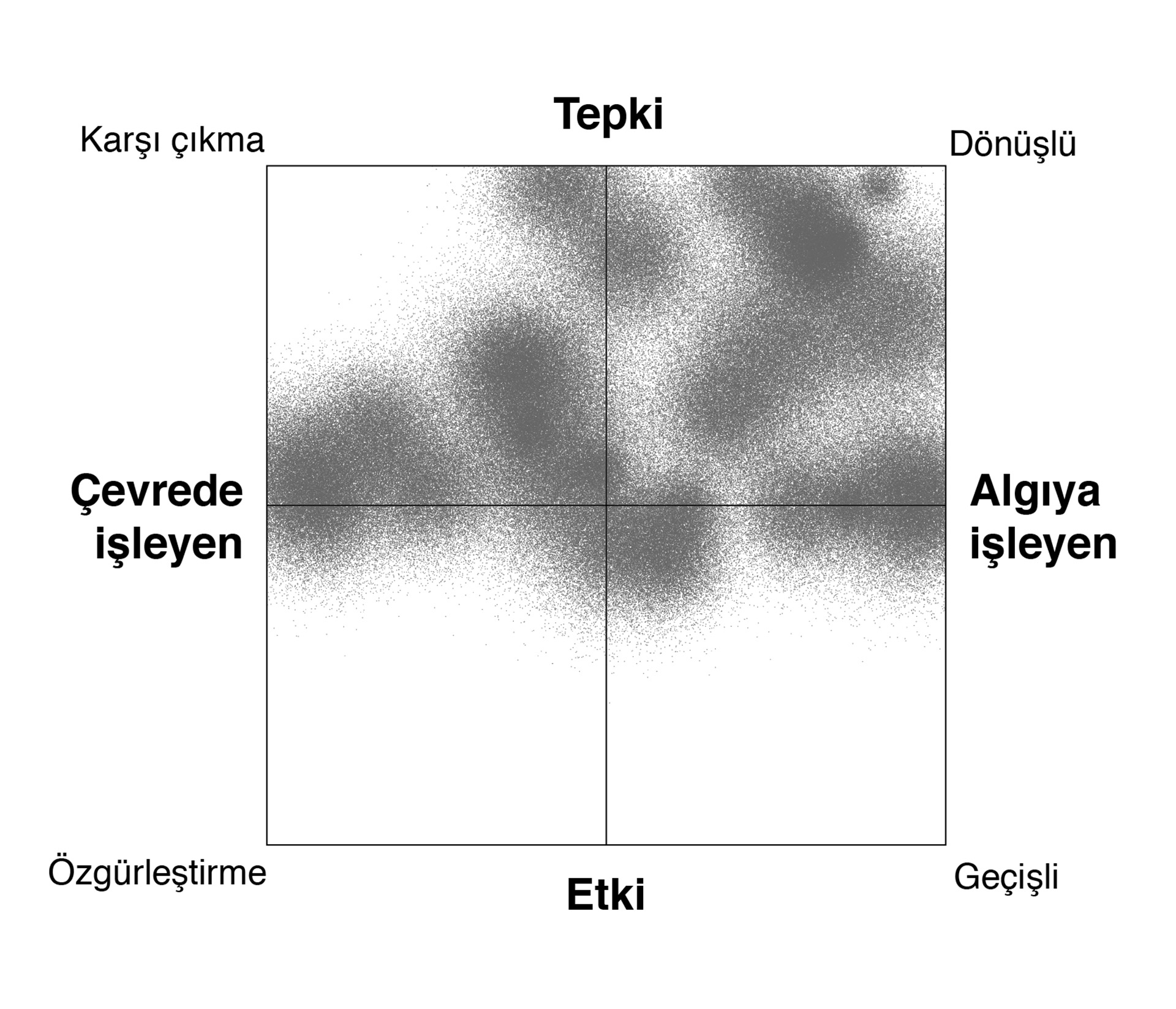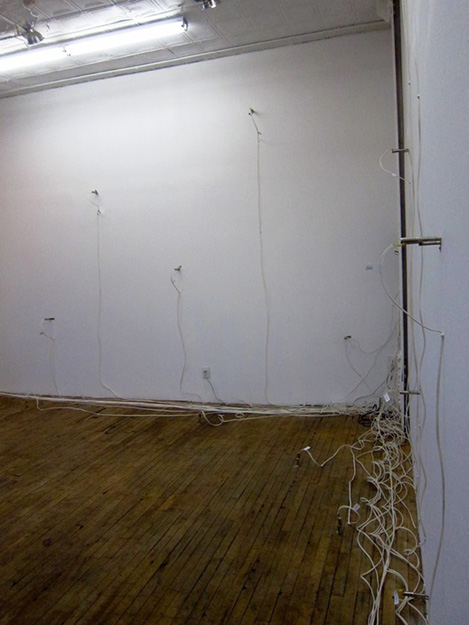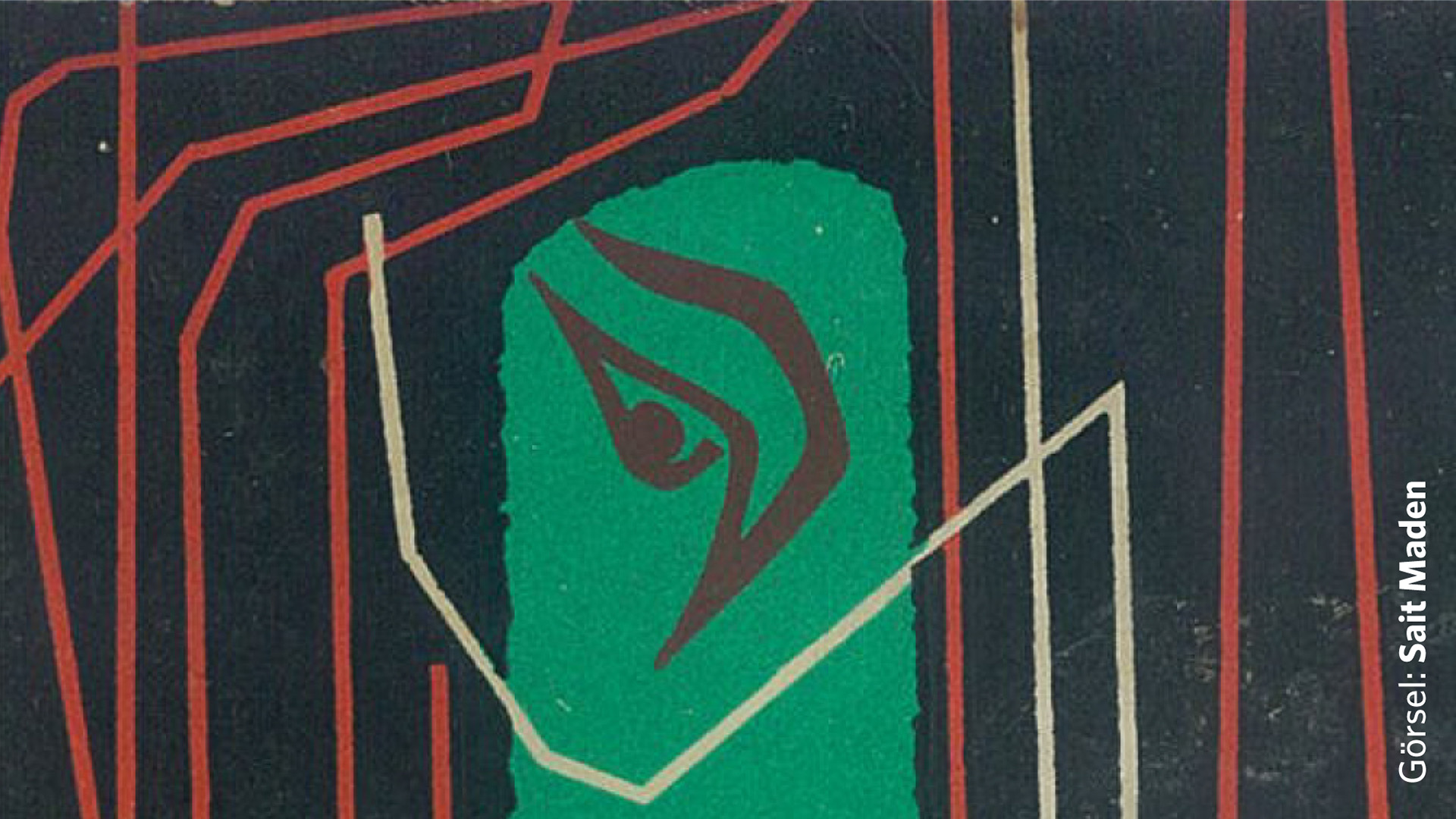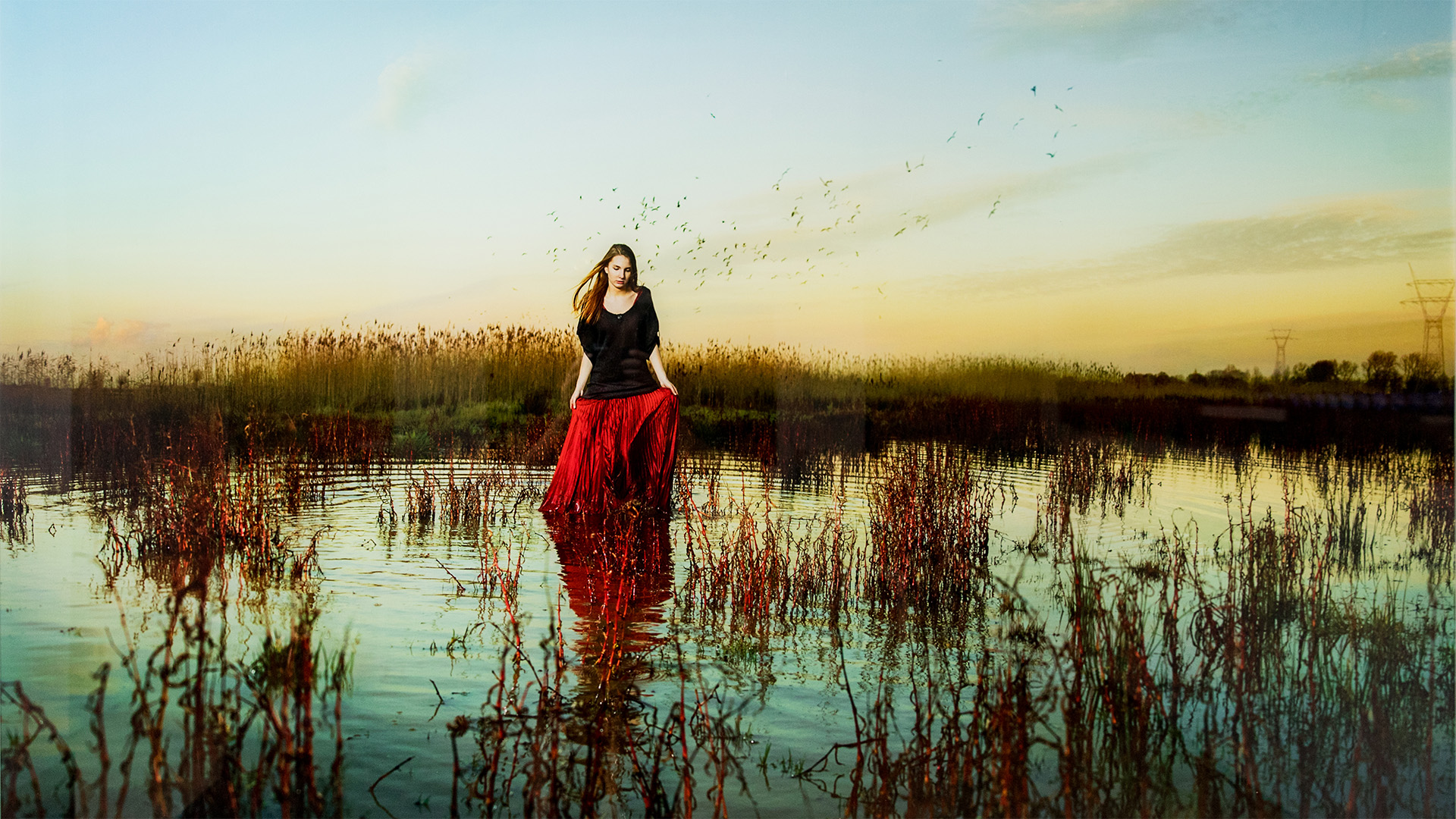Blog
Internet and digital technologies to the physicality of communication: Ali Miharbi’s artistic practice
26 December 2018 Wed
Borusan Contemporary kicked off the new season’s conversations on art and technology with a detailed presentation by Fatih Aydoğdu on the history of the use of sound in New Media. In October, Ali Miharbi, an artist from Turkey who often uses sound in his installations, discussed his works within the framework provided by Aydoğdu. Rumeysa Kiger interviewed the artist after his talk.

RUMEYSA KİGER
rumeysa.kiger@gmail.com
Rumeysa Kiger: You started your talk by showing a diagram by Brian Schrank, used to group video games, to show where your works are positioned and where your desire to produce work comes from. In the version of this diagram that you have re-labeled, you place yourself on reaction on the Reaction/Action axis; on the perceptually immersive on the Environmentally immersive/Perceptually immersive axis, and on the reflection function in the Communication/Reflection axis. Could you elaborate on these ideas? First of all, are these positions specifically about your sound works?
Ali Miharbi: These positions apply not only to my sound works, but to all my works. Actually, it’s possible something problematic to place a work on a point there, because at the end of the day, you would be reducing a layered experience with many parameters onto two parameters. But of course, just with any other mapping, there are parts that do not apply to reality. It is useful in the sense that it presents an alternative to descriptions that count off aspects of the work or that place the work on a line between two opposites.
R. K.: For example, could you discuss your work Stroke using this diagram?

A. M.: This diagram is just one example in conceptualizations using four corners, based on two sets of opposites that are independent from each other. Instead of one set of opposites placed on one axis, by using two axii that intersect each other, a relational map can be derived at and I find this important. Such groupings of four is a tool of thinking in many differeent disciplines. For example, Aristoteles’s four causes theory, Tinbergen’s four question to dissect animal behavior, Greimas’s semiotic square, SWOT analysis that is used in business, Kolb’s learning cycles could be listed as examples of such two-dimensional mappings. Just like any other mapping system, it simplifies more complicated and detailed systems; the world map that we look at on a sheet of paper or on the screen is a projection of a three-dimensional surface on two dimensions and similarly, many of these maps can overlook some of the variables that could be influencing the system that they are looking at. A two-dimensional axis is thus not sufficient (for example, the algorithms that are used today in maching learning can use concept spaces that have hundreds, thousands of dimensions to model the meanings of words in naturally occurring langusges). However, I could say that it is a step beyond a single set of opposites. For example, some discussions of art works can be reduced to “political-formal”, “social-personal”. I also find conceptualizing and mapping video games, artists, and theoreticians on the same map: Peter Bürger, JODI, Nintendo, Fluxus and Minecraft are on the same map! My use of this diagram in presentations is to use it as an invitation to open up discussions of these concepts using different variables.
Showing my own production on this map is impossible to do with certainty. But perhaps we could talk about an inclusion like what I’m showing below.

If we look at Stroke specifically, it is possible to say that the space and the material are foregrounded. The shop windows are interacting with the objects that are moving and the viewers can listen to the sounds through the speakers placed outside as they are watching the images. In this sense, the material is self-referential; it is “reflexive”. Furthermore, there is also the aspect of language; the departure point is about language. To be more specific, thinking about the most primitive form of language, what it means to be positioned between the physical action and language, delving into the roots of meaning through coincidences, repetitions, weavings motivate the work. When we look at the work from this perspective, it is positioned in the action and perception segment, as there are many references and associations to the outside. The image above is not analyzing the work, but it is not too far from it.

Ali Miharbi, Stroke, 2014
R. K.: An artwork often has many dimensions and one of the things that people who do not make art are very curious about is how these layers of association and research come together. Since we are already talking about the diagram, where in the diagram is your starting point and in which direction do you move? Could you talk about this process?
A. M.: The starting point in my work-making practice is not always at the same place, but no matter where it starts, it settles and matures in a specific orbit as a result of the interactions between the materials I know and through the familiar and unfamiliar aspects of the methods. Sometimes the idea can be very decisive, sometimes a more ambiguous idea can be re-shaped by interacting with uncertainties about its implementation. It is possible to talk about an interaction between what I know before, what I can learn in that process and what I would never know; including questions about how we live socially, historically, personally and even physically.
R. K.: You also gave examples of artists who inspired you or who you are impressed by. For example, you talk about how the sound of David Tudor's Rainforest work or Mark Hansen & Ben Rubin's Listening Post's live broadcasting of the conversations in the chat rooms inspired Whisper or Séance. In addition, in the description of 3D Print Embodied by the Mouse Movements of its Own Purchasing, you also write about the reference to Robert Morris's Box with the Sound of Its Own Making. Art production is of course a field of study, artists examine, inspire and refer to their predecessors, but how do you think the boundaries of this interaction are drawn? I thought that your works with an obvious political subtext are removed from directly referencing, perhaps due to the local circumstances. What do you think?
A. M.: If there is a work that comes to my mind at the idea or production stage and that affects the process, I like to talk about it in a way because it makes my method a little more obvious. This effect can occur in many different ways: Sometimes it can be a starting point, and then I can completely break off from there. Sometimes it can help solve a knot in the work, and sometimes it points to a paradigm shift by creating contrast. For instance, it was a work that emerged through a comparison of art history with the change of the common mode of production through mouse movements and the change of the common mode of production (from industrial production to the production of information-based production); I retained this cyclicality within the work. It's a little bit like "now we're somewhere else". The effects of the Séance work are not so direct: When I look at the elements that constitute the work, I can see some similarities with other works. There is a relationship with David Tudor's Rainforest work, the space / sound relationship, the action of vibrating the space directly. Mark Hansen & Ben Rubin's Listening Post installation has a common feature of collecting the live messages on the Internet in one place. But I had never seen a work that does both: a physical action on the Internet of live messages in the space, walls, pipes, windows, flooring, the whole architectural structure is work that vibrates and moves. The important thing for me here was that the idea of the work coincided with the changes in the world (2011) and the changes that I felt in my life: Social media had become more widespread and hybridized the virtual-physical distinction previously presented as a duality. From a different standpoint, my master's thesis was a work that consisted of a bicycle wheel mechanism connected to the Internet. In short, these influences are not in a linear but complex network and they can go on and on any or many of the processual, formal, intellectual, contextual planes. In addition, sometimes, personal, social, political contexts can be outweighed by all kinds of art historical connections.
R. K.: While some of your works are experimental in that you research the limitations of materials, sounds, and spaces, while other works have a more obvious socio-political subtext. Do you think these works with subtexts are evolving in a more experimental dimension over time? For example, your work Delegations from 2007-2008 reflected images of the faces of parliament members using a digital mirror while your work The Whisper from 2016 uses only the throat and alphabet. Do you also feel a strong difference here or a transition over time?
A. M.: There has, of course, been a change over time and that change continues. I think it's a pleasure to be on such a journey. However, it is difficult to define this change as a shift from work with a socio-political message to experimental work. it is more like a stopover during a trip. I also like to make works that operate on completely different planes simultaneously. For example in the Pneuma exhibition, I exhibited the Sesliler, a continuation of the Whisper project at the Pilot Gallery (2017, http://www.pilotgaleri.com/en/exhibitions / detail / 85) as well as TV Eyes, which had more recent and direct references: There was a screen placed high on the wall, a software took the eyes of the people in the live broadcast of CNN Turk and magnified them so that there was nothing but the eyes on the screen. There was no sound, just eyes. Both works were produced in the same period, but if the mapping that I used in the presentation was used, it could probably be seen to be placed in completely different places. As such, I can think of different projects as different layers of abstraction.
In addition to all of these, if I were to summarize the transition I went through, I was working on the Internet to begin with, experimenting with the possibilities of the Internet, looking at the political effects of digital technologies in general. Now, using exactly those technologies, I have moved on to works in which I use precisely that language to narrate, delving deeper into the roots and the physicalities of the notions of communication, conversation, information, and meaning. In practice, all of these things are very interwoven and they perhaps inspire each other.
R. K.: During your talk, you showed examples of trials for your work Wind Organ that you installed at the gardens of the Horniman Museum. If I’m not mistaken, you first looked at how to make sounds with plastic pipes. Could you talk about this process of experimentation? There is an experimentation that is structural to the work, but I’m sure you had to go through many materials to get the right materials. The material then informs the transformation of the form. For example, in Machine that Whips the Wall, the type of whip used affected the traces on the wall. But perhaps you have experienced situations where this interaction was even more clear?
A. M.: Yes, the Wind Organ was a work in which the relationship between the material and the idea were tightly bound. The idea was realized in a way that was completely unforeseen. The idea, the production process, the open-air conditions and the trials that I did, the information that I gathered online on instruments that use the wind as documented online merged with the simulations that I did on the production of sound in human beings. The work became more minimal and instead of trying to mimic the human voice, referring to the museum’s already-existing collection of music instruments and creating a form that was inspired by the human throat made more sense, which resulted in a large-scale outdoors installation using giant flutes. Not every project works like this; the idea might be very clear and the application could be very straight-forward. But when the idea and the material influence each other, the surprises that arise can be the foundations of future projects. This holds the potential of not only transforming me, but also creating an idea-form oscillation in the minds of the viewers.
R. K.: You studied both engineering and art at the university. Why did you to do these two degrees together? Though perhaps it is not too surprising since you were in America, but nevertheless, it is a different situation to study two very different things together, as this opportunity does not exist in Turkey. As these works did not exist back in the day and since you were just a student at the university, did you have a clear idea of how things were going to go? Or did you have to be an engineer when in reality, you wanted to study art and your story is that the two ended up coming together?
A. M.: It was a long time ago, so what I learned and what I did at that time, and my current thinking and practice were very different. Looking at the technical part of the projects I have been working on in recent years, rather than being related to engineering, the things that are produced are done with an amateur spirit, a ’do-it-yourself' approach. I also studied painting as an undergraduate, but rather than the production of two-dimensional image, spreading into the space or processes are things that I'm more interested in for a long time. In my years at school, I had no clear idea of joining two fields of knowledge, but in my last year (in 2000) I produced some work on the Internet.
R. K.: And you did your master's degree in a highly hybrid field of Kinetic Image-making. This is another part that encourages students to bring together technical information and visual image. Could you tell us a little about this section and the effects of what you learned there?
A. M.: Even though my master's program (2008-2010) focused on video / animation / sound as a department, the program was quite open-ended and it was a productive process where I could concentrate on my ideas and implementing them, experimenting and figuring things out. I was also interested in the use of sound under the influence of the artist Stephen Vitiello, one of the professors at the school. This is a process that becomes increasingly more important over the years and I still do not know it is going exactly.
ABOUT THE WRITER
Rumeysa Kiger is an art critic and a cultural influencer. A member of the AICA International Art Critics' Association, Kiger founded the digital art publication, "Çok iyi işler", which is available on WhatsApp, Instagram, and YouTube. She studied at the Bosphorus University in the Philosophy Department and completed her graduated studies at the Cultural Management Department of Bilgi University.







